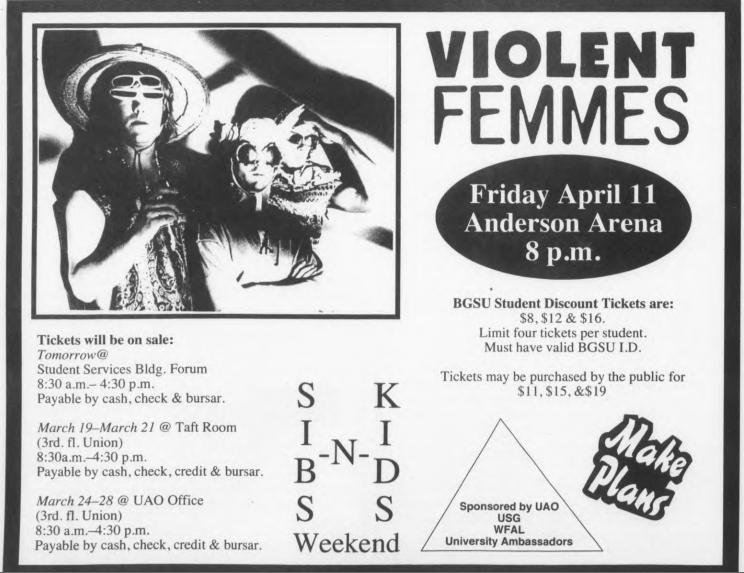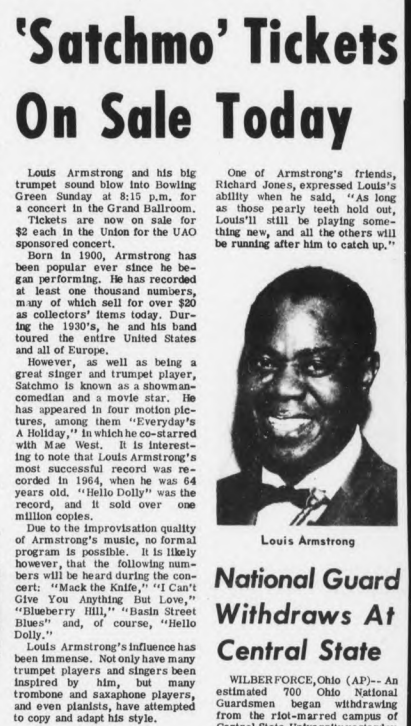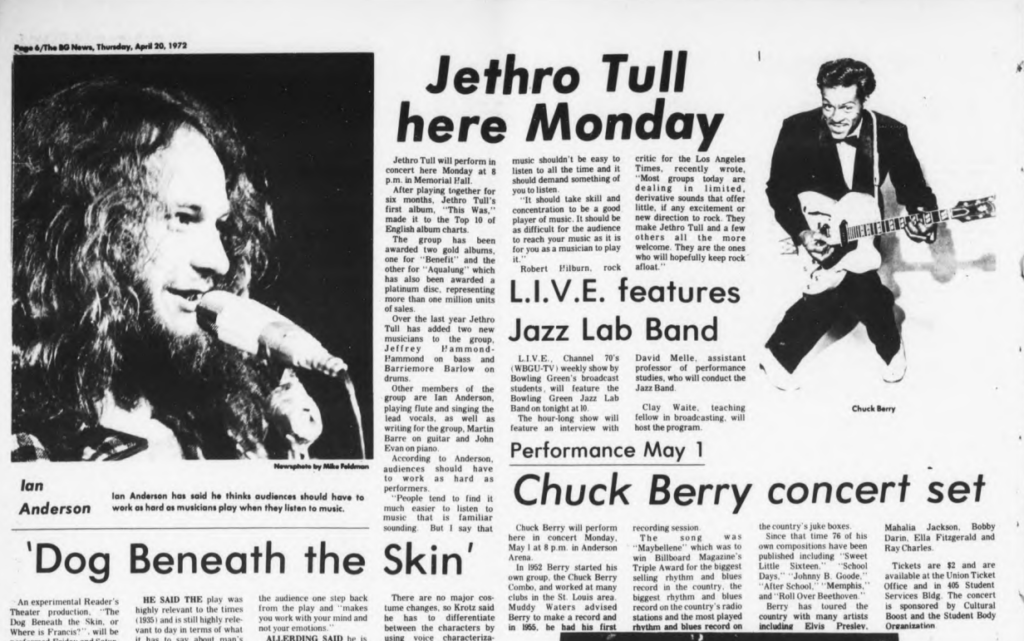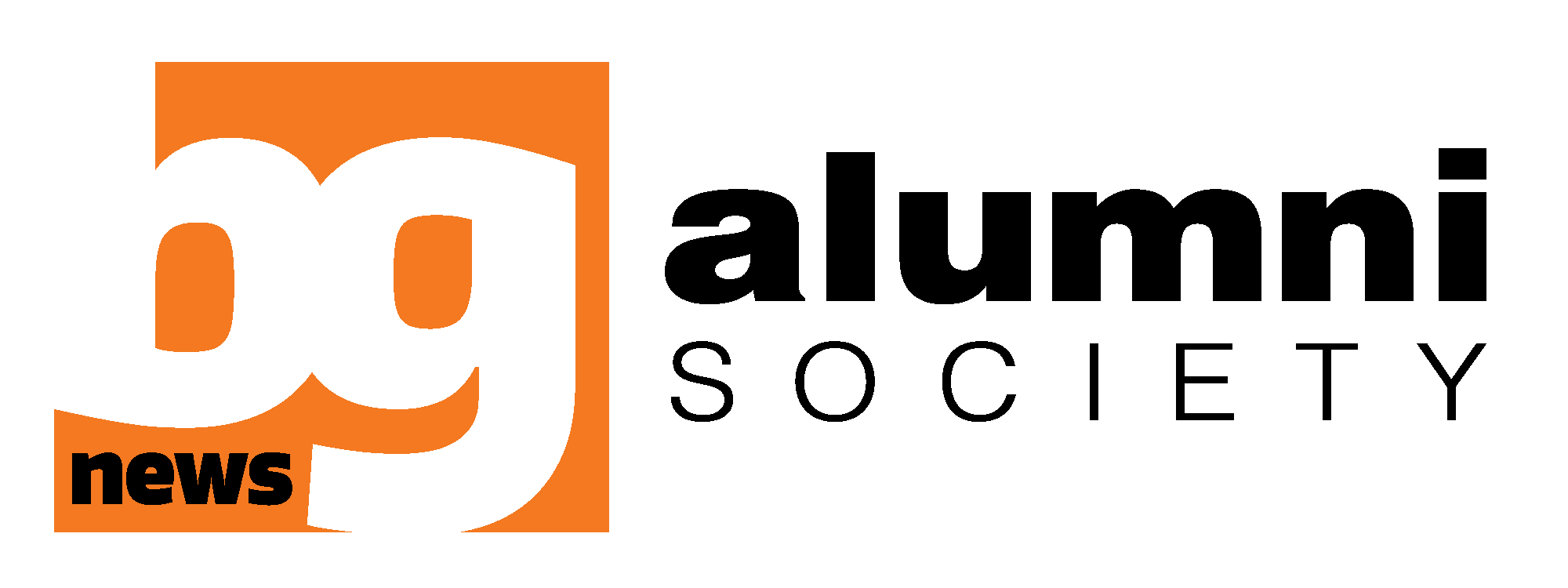How big was the Tommy Dorsey Orchestra in the 1950s?
Big enough to earn a six-column headline spanning the top of the BG News front page on the Tuesday, Oct. 14, 1958 edition: Tommy Dorsey Band To Play At Homecoming.
The concert, it should be noted, did not actually feature Dorsey himself. The bandleader had died two years earlier and musician Warren Covington led the touring group.

This was the Tommy Dorsey Orchestra’s first ever trip to Bowling Green. The group headlined the 1958 Homecoming Dance, sponsored by the sophomore class and held in the Student Union’s Grand Ballroom. Students were urged to buy their tickets early, as alumni would be snatching them up as well.
In the end, the sophomore class sold more tickets than the Grand Ballroom’s actual capacity.
“Dancing in the Ballroom, usually a pleasure, turned out into a crowded inferno and spectacular flop Saturday night,” two students wrote in a subsequent BG News Letter to the Editor. “Many students and alumni having paid their two dollars for tickets were unable even to enter the Ballroom and the unlucky souls who managed to get inside, found themselves in a situation comparable to the New York subway during rush hour.”
This was not the only instance of a “big band” performing on campus that fall. Nor was it even the only one named after a deceased bandleader.
The Glenn Miller Orchestra (so named for the popular musician who disappeared during a European flight in 1944) performed for the senior class in the Grand Ballroom that November.
1960s
Tickets were still $2 apiece when legendary trumpeter Louis Armstrong performed in the Grand Ballroom in November 1967.
Satchmo was just a few years off of reaching No. 1 on the Billboard charts with “Hello, Dolly!” when he arrived to town. The BG News previewed the concert by profiling his career, noting other jazz hits like “Mack the Knife” and “Basin Street Blues.”

1970s
The Father of Rock and Roll, along with one of the most commercially successful rock bands of the 1970s, performed in Bowling Green on back-to-back Mondays in 1972.
Jethro Tull performed at Anderson Arena on April 24. The group’s lead vocalist, Ian Anderson, was quoted as saying “people tend to find it much easier to listen to music that is familiar sounding. But I say music shouldn’t be easy to listen to all the time and it should demand something of you to listen.”
Chuck Berry arrived on campus a week later for a concert sponsored jointly by Cultural Boost and the Student Body Organization. Tickets to see the music legend cost just $2.
1980s
BGSU hadn’t seen a major concert in two years when the Australian rock group INXS performed at Anderson Arena.
“Concert success for UAO,” The BG News raved, giving compliments to the University Activities Organization for drawing more than 4,000 attendees.
1990s
By the mid-1990s, BGSU was once again hoping to return to its live music glory days. President Sidney Ribeau challenged student groups to book major acts for campus performances. (Such events were encouraged as a way to keep students on campus during weekends.)
The BG News held a poll to see which music act students wanted most. Rusted Root, a rock band from Pittsburgh, won the poll. When the groups struggled to book Rusted Root, they turned to another popular choice: The Violent Femmes, which agreed to play for a $20,000 booking fee.
The band performed on April 11, with the concert sponsored by UAO, the Undergraduate Student Government, University Ambassadors and the WFAL radio station. Tickets were available between $8-19 and they went fast, owing to it being Sibs ‘N Kids Weekend. Advertisements noted that students could pay for tickets by cash, check, creditor and bursar.
Reporters Brandon Wray and Tod McCloskey covered the concert and wrote the band “brought their quirky and offbeat stage show to Bowling Green for a concert that was well-received by University students.”
“With this concert Bowling Green had the opportunity to prove that it was a real concert going community and not just a bunch of drunks looking to hear ‘Blister in the Sun’ and kill time before they went to the bars,” they added.
2000s
BG News editor-in-chief (and current BG News Alumni Society board member) Brandi Barhite reported quite a scoop in March 2000: The spring concert that semester would feature the band Bush and singer/songwriter Moby.
(This was especially good news, Barhite wrote, considering a planned 1999 concert featuring They Might Be Giants fell through.)
This would be no ordinary concert — the April 11 performance was also scheduled to be part of the MTV Campus Invasion Tour. It cost a whopping $100,000 to book the show.
Tickets cost between $16-22 and were sold at Boogie Records in Toledo, Madhatter Music in Bowling Green and inside Olscamp Hall.
It was the talk of campus for much of March and April. The BG News ran a “People on the Street” question asking students, “Who manages money better: men or women? Why?”
A student named Jameson answered, “Women because there are men who have been standing in line for 12 hours for Bush and Moby tickets.”
This self-deprecating answer was more chivalrous than the one offered by a student named Michael the day after the concert. Asked how long he waited for tickets, Michael responded: “I didn’t wait. I had some girl get my ticket.”
Not everyone was enthusiastic about the concert, and in fact it turned into something of a racial debate. Students of color wrote letters and columns in the student newspaper criticizing the choice of music act, claiming UAO did not take into account the preferences of Black, Hispanic or Asian students.
“The minority students don’t even make up 20 percent of the student population,” columnist Erin Bailey wrote in an article entitled, “Campus needs to accommodate minorities.”

“So of course two white bands which I have never heard of will be the ones that are picked … I am not saying that Bush and Moby shouldn’t have been asked to come but I do think there should have been different kinds of music, music other than alternative rock, so everyone could enjoy the concert.”
On the big day, MTV set up an interactive village next to Anderson Arena. Students auditioned for shows like “The Real World” and tried out as “video jockeys.” The network showcased new music videos and offered tips from “MTV’s House of Style.” There was also a voter registration booth, given it was a presidential election year.
Some were disappointed that a widely-publicized daytime performance from Bree Sharp was canceled at the last minute.
The music performances from Moby and Bush later in the evening went over well. But UAO didn’t get to celebrate much. After facing weeks of criticism about the bookings, they were pilloried even more afterward for selling more tickets than could even fit in the arena.
This led organizers to assign ticket holders the night of the show, with some being relegated from floor seats to watching high up in the bleachers.
“We did not wait in line for 12 hours to sit up high,” seven students wrote in a collective letter to the editor.
That was better than what a student named Monica experienced. Despite camping out for her ticket, she described having to wait an hour in an Anderson Arena will call line to pick it up. By the time she got inside, Moby had already finished performing.
2010s
Kesha performs Jan. 27, 2017. Backed by her band, The Creepies. Held in the Stroh Center, new home for most big events on campus.
“The crowd left the show with sore throats and tired legs,” reporter Meredith Siegel wrote, “which are the marks of a good concert.”
